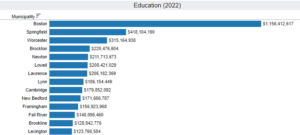Why The Best Public Schools Are The Best
Massachusetts’ education system is famously excellent, routinely ranking at the top of the nation. Even in Massachusetts, however, some public school districts such as Brookline, Newton, Wellesley, and Weston consistently perform better than others and post higher standardized test scores.
In fact, according to Mass Report Cards, in the 2022-23 school year, 88 percent, 84 percent, and 75 percent of sophomores at Weston High achieved scores meeting or exceeding expectations respectively on the English Language Arts, Math, and Science MCAS tests, far exceeding the respective statewide public school averages of 60 percent, 53 percent, and 50 percent.
Many attribute this success to funding; all these towns dedicate significant resources to their public schools. Brookline spent $128,842,776 on education in 2022. Newton meanwhile spent $211,713,673. They ranked 12th and 5th in Massachusetts, respectively, for total education spending. Wellesley and Weston are far smaller towns than Brookline and Newton and thus allocate less money to their public school system. However, they still dedicate significant money, leading to their stellar rankings and reputations.

Figure 1: Mass Analysis (2022)
Despite spending liberally on education, these towns fall short in a key metric often associated with a school’s success: spending per student. Brookline ranks 48th, Newton 79th, Wellesley 57th, and Weston 25th, according to Mass Analysis. These rankings are not low, but they are far from the powerhouse numbers one might expect from some of the state’s top-rated public schools, as these four school systems respectively ranked 3rd, 5th, 6th, and 2nd in Massachusetts, according to Niche.com.
This may be caused by resources available outside of schools, as these towns are among the wealthiest in Massachusetts. In 2023, Brookline’s average single-family tax bill was $21,322, the second highest in Massachusetts, while Weston was the highest with an average single-family tax bill of $23,893. While Newton and Wellesley are not quite as wealthy by this metric, they are still among the wealthiest towns in the state, creating many opportunities outside of school, such as private tutoring or internships.

Figure 2: Mass Analysis (2023)
Corresponding to the wealth of these towns is their low crime rates. Since, according to the NIH, high crime rates can negatively impact academic performance, these towns experience another advantage. In 2021, the violent crime rate in Brookline was 221 per 100k population, significantly less than the 301 per 100k population across Massachusetts. Wesley, Weston, and Newton all experienced higher violent crime rates than Brookline, but were still well below the statewide average. This could contribute to the better results these schools produce.

Figure 3:Mass Analysis (2021)
Household environment can also play a significant role in educational performance, as students in more affluent families are more likely to gain knowledge at home than students in poorer families. Studies have shown that a significant gap in vocabulary can develop even between toddlers who grow up in rich and poor households respectively. Thus, students in wealthy towns like Brookline, Weston, Newton, and Wellesley, have advantages even before schools are taken into account. Since the wealth of these towns also leads to lower crime rates and more opportunities for students, these schools attain excellent results even without spending the most money per student.
About the Author: Raif Boit is a Roger Perry Transparency Intern at Pioneer Institute for the summer of 2024. He is a rising freshman at Harvard College.



